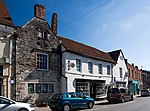Wimborne Minster (church)
8th-century church buildings in England8th-century establishments in EnglandAnglo-Saxon monastic housesBenedictine monasteries in EnglandBurial sites of Anglo-Saxon royal houses ... and 7 more
Church of England church buildings in DorsetChurches completed in 705Former Royal PeculiarsGrade I listed churches in DorsetMajor Churches NetworkMonasteries in DorsetWimborne Minster

Wimborne Minster is the parish church of Wimborne, Dorset, England. The minster has existed for over 1300 years and is recognised for its unusual chained library (one of only a few surviving chained libraries in the world). The minster is a former monastery and Benedictine nunnery, and King Æthelred of Wessex is buried there.
Excerpt from the Wikipedia article Wimborne Minster (church) (License: CC BY-SA 3.0, Authors, Images).Wimborne Minster (church)
High Street,
Geographical coordinates (GPS) Address Phone number Website External links Nearby Places Show on map
Geographical coordinates (GPS)
| Latitude | Longitude |
|---|---|
| N 50.798888888889 ° | E -1.9880555555556 ° |
Address
Minster of St. Cuthburga
High Street
BH21 1HT
England, United Kingdom
Open on Google Maps









